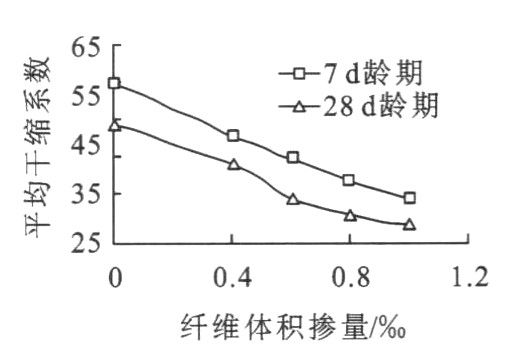Shrinkage properties of cement stabilized macadam reinforced with polypropylene fiber
-
摘要: 为了减小水泥稳定碎石的收缩, 研究了聚丙烯纤维对水泥稳定碎石收缩性能的影响, 分别用千分表支架法和应变片电测法对聚丙烯纤维水泥稳定碎石和普通水泥稳定碎石的干缩性能和温缩性能进行了测试, 分析了材料的平均干缩系数和平均温缩系数随纤维掺量变化的规律。试验结果表明: 聚丙烯纤维的掺入可显著地减小水泥稳定碎石的平均干缩系数和平均温缩系数, 高龄期聚丙烯纤维水泥稳定碎石的平均干缩系数比低龄期的小, 而高龄期的平均温缩系数却比低龄期的大; 在纤维体积掺量小于1‰的范围内, 随着纤维体积掺量的增加, 水泥稳定碎石平均干缩系数和平均温缩系数均逐渐减小。可见, 在一定的纤维掺量范围内, 聚丙烯纤维水泥稳定碎石具有良好的抗收缩性能, 应用于路面基层可提高路面的抗裂性能。Abstract: In order to decrease the shrinkage of cement stabilized macadam, the influences of polypropylene fiber on the shrinkage properties of cement stabilized macadam were studied, its dry shrinkage property was measured by using micrometer gauge method, and its thermal shrinkage property was measured by using strain gauge method, the rules of its average dry shrinkage coefficient and average thermal shrinkage coefficient with the variation of the fiber volume content were analyzed.Test result shows that the addition of polypropylene fiber can observabley decreases the average dry shrinkage coefficient and average thermal shrinkage coefficient, the average dry shrinkage coefficient of long curing period is smaller than that of short curing period, while the average thermal shrinkage coefficient of long curing period is larger than that of short curing period.When the fiber volume content is less than 1‰, the average dry shrinkage coefficient and average thermal shrinkage coefficient observably decrease with the increase of polypropylene fiber dosage.So cement stabilized macadam reinforced with polypropylene fiber has favorable resistance on dry shrinkage and thermal shrinkage when the fiber volume content is appropiate, and its application in base course can improve the anti-cracking performance of pavement.
-
表 1 聚丙烯纤维物理性能
Table 1. Physical properties of polypropylene fiber
密度/(g·cm-3) 线密度/dtex 长度/mm 抗拉强度/MPa 拉伸极限/% 弹性模量/MPa 熔点/℃ 0.91 10~20 10~20 ≥450 ≤28 ≥4 100 160~170 表 2 碎石级配
Table 2. Gradation of macadam
方筛孔尺寸/mm 31.5 19 9.5 4.75 2.36 0.6 0.075 通过质量百分率/% 100.00 94.30 67.64 41.96 26.90 9.68 0.26 表 3 击实试验结果
Table 3. Result of compaction test
配比编号 纤维体积掺量/‰ 最佳含水量/% 最大干密度/(g·cm-3) S1 0.0 5.52 2.29 S2 0.4 5.62 2.31 S3 0.6 5.72 2.31 S4 0.8 5.61 2.29 S5 1.0 5.58 2.32 表 4 不同含水量下的干缩系数
Table 4. Dry shrinkage coefficients under different water contents
配比编号 S1 S3 项目 ωi-ωi-1/% ωa/% Δω/% αd ωi-ωi-1/% ωa/% Δω/% αd 项目值 4.71~4.01 4.36 0.70 56.7 4.790~4.150 4.47 0.64 34.58 4.01~3.33 3.67 0.68 55.3 4.150~3.570 3.86 0.58 36.00 3.33~2.85 3.09 0.48 59.1 3.570~3.060 3.32 0.51 37.56 2.85~2.63 2.74 0.22 64.4 3.060~2.680 2.87 0.38 44.73 2.63~2.33 2.48 0.30 66.6 2.680~2.280 2.48 0.40 20.00 2.33~2.09 2.21 0.24 70.7 2.280~2.000 2.14 0.28 50.78 2.09~1.73 1.91 0.36 56.5 2.000~1.615 1.81 0.38 46.26 1.73~1.27 1.50 0.46 42.8 1.615~1.245 1.43 0.37 35.60 1.27~0.75 1.01 0.52 27.1 1.245~0.845 1.05 0.40 18.90 0.75~0.49 0.62 0.26 9.2 -0.845~0.455 0.65 0.39 8.70 表 5 干燥收缩和温度收缩试验结果
Table 5. Results of dry and thermal shrinkage tests
配比编号 Vf/‰ Δω/% εd/10-6 εt/10-6 αd αt 7 d 28 d 7 d 28 d 14 d 28 d 7 d 28 d 14 d 28 d S1 0.0 4.08 4.30 235 212 435 480 57.6 49.3 7.25 8.00 S2 0.4 4.20 4.35 197 179 417 465 46.9 41.1 6.95 7.75 S3 0.6 4.18 4.42 177 151 403 433 42.3 34.2 6.42 7.22 S4 0.8 4.14 4.32 156 132 350 404 37.3 30.6 5.83 6.73 S5 1.0 4.05 4.23 138 121 326 378 34.1 28.6 5.43 6.30 表 6 不同降温段的温缩系数
Table 6. αtof different temperature descending periods
降温段/℃ αt/(10-6·℃-1) 配比S1 配比S3 30~40 8.7 7.5 20~30 8.0 7.6 10~20 8.1 7.4 0~10 7.4 6.9 -10~0 8.2 7.2 -20~-10 7.6 6.8 -
[1] 王宏畅, 黄晓明, 傅智. 半刚性基层表面裂缝影响因素[J]. 交通运输工程学报, 2005, 5(2): 38-41. doi: 10.3321/j.issn:1671-1637.2005.02.010WANG Hong-chang, HUANG Xiao-ming, FU Zhi. Influence factors on surface crack of semi-rigid base course[J]. Journal of Traffic and Transportation Engineering, 2005, 5(2): 38-41. (in Chinese) doi: 10.3321/j.issn:1671-1637.2005.02.010 [2] 杨红辉, 郝培文, 戴经梁. 掺膨胀剂水泥稳定碎石路用性能[J]. 交通运输工程学报, 2006, 6(1): 48-51. doi: 10.3321/j.issn:1671-1637.2006.01.010YANG Hong-hui, HAO Pei-wen, DAI Jing-liang. Road performance of cement-stabilized aggregate mixture with expansion agent[J]. Journal of Traffic and Transportation Engineering, 2006, 6(1): 48-51. (in Chinese) doi: 10.3321/j.issn:1671-1637.2006.01.010 [3] 蒋应军, 薛航, 薛辉, 等. 半刚性基层预锯缝及铺土工布的路面防裂措施[J]. 长安大学学报: 自然科学版, 2006, 26(2): 6-9. https://www.cnki.com.cn/Article/CJFDTOTAL-XAGL200602001.htmJI ANG Ying-jun, XUE Hang, XUE Hui, et al. Preventing cracks of asphalt pavement based on pre-cutting crack and paving geotextile at semi-rigid type base[J]. Journal ofChang an University: Natural Science Edition, 2006, 26(2): 6-9. (in Chinese) https://www.cnki.com.cn/Article/CJFDTOTAL-XAGL200602001.htm [4] 王亚玲, 张尚昆, 颜祖兴, 等. 土工格栅加筋水泥稳定碎石材料的疲劳试验[J]. 长安大学学报: 自然科学版, 2006, 26(2): 18-21. doi: 10.3321/j.issn:1671-8879.2006.02.005WANG Ya-ling, ZHANG Shang-kun, YAN Zu-xing, et al. Fatigue test of cement stabilization macadamin geogrid[J]. Journal of Chang an University: Natural Science Edition, 2006, 26(2): 18-21. (in Chinese) doi: 10.3321/j.issn:1671-8879.2006.02.005 [5] 肖成志, 栾茂田, 杨庆, 等. 土工格栅经验型蠕变模型及其参数试验[J]. 中国公路学报, 2006, 19(6): 19-24. doi: 10.3321/j.issn:1001-7372.2006.06.004XI AO Cheng-zhi, LUAN Mao-tian, YANG Qing, et al. Experiment on empirical creep model and its parameters ofgeogrids[J]. China Journal of Highway and Transport, 2006, 19(6): 19-24. (in Chinese) doi: 10.3321/j.issn:1001-7372.2006.06.004 [6] 王亚玲, 周玉利. 土工格栅加筋半刚性基层材料的抗弯拉强度试验[J]. 长安大学学报: 自然科学版, 2006, 26(5): 26-29. doi: 10.3321/j.issn:1671-8879.2006.05.007WANG Ya-ling, ZHOU Yu-li. Anti-flexural-tensile strength test of semi-rigid type base course materials reinforced bygeogrid[J]. Journal of Chang an University: Natural ScienceEdition, 2006, 26(5): 26-29. (in Chinese) doi: 10.3321/j.issn:1671-8879.2006.05.007 [7] 胡龙泉, 蒋应军, 陈忠达, 等. 骨架密实型水泥稳定碎石路用性能[J]. 交通运输工程学报, 2001, 1(4): 37-40. doi: 10.3321/j.issn:1671-1637.2001.04.008HU Long-quan, JI ANG Ying-jun, CHEN Zhong-da, et al. Road performance of cement stabilized aggregate of dense framework structure[J]. Journal of Traffic and Transportation Engineering, 2001, 1(4): 37-40. (in Chinese) doi: 10.3321/j.issn:1671-1637.2001.04.008 [8] 杨红辉, 王建勋, 郝培文, 等. 纤维在水泥稳定碎石基层中的应用[J]. 长安大学学报: 自然科学版, 2006, 26(3): 14-16. https://www.cnki.com.cn/Article/CJFDTOTAL-XAGL200603003.htmYANG Hong-hui, WANG Jian-xun, HAO Pei-wen, et al. Utilization of fibrein cement-stabilized aggregate mixture[J]. Journal of Chang an University: Natural Science Edition, 2006, 26(3): 14-16. (in Chinese) https://www.cnki.com.cn/Article/CJFDTOTAL-XAGL200603003.htm [9] JTJ 057—94, 公路工程无机结合料稳定材料试验规程[S]. [10] BANTHI A N, GUPTA R. Influence of polypropylene fibergeometry on plastic shrinkage cracking in concrete[J]. Cement and Concrete Research, 2006, 36(7): 1263-1267. [11] BAYASI Z, MCI NTYRE M. Application of fibrillated poly-propylene fibres for restraint of plastic shrinkage cracking insilica fume concrete[J]. ACI Materials Journal, 2002, 99(4): 337-344. [12] GONZALO M B, ENRI QUE V S, SUSANA H L, et al. Mechanical improvement of concrete by irradiated polypropy-lene fibers[J]. Polymer Engineering and Science, 2005, 45(10): 1426-1431. [13] 蒋应军. 水泥稳定碎石基层收缩裂缝防治研究[D]. 西安: 长安大学, 2001. -





 下载:
下载:





